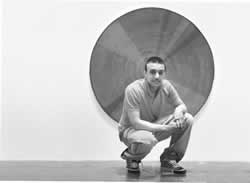A Campaign for Equity: In the Neighborhood
Theory...Meet Practice
A high school founded by TC uses the
Holistic art experience-or just a bunch of soccer goals draped in orange? When The Gates came to
"I think they're really beautiful," says Ramirez, who also happens to lead tours at the city's
If you're wishing your own kid could offer a critique like that, you might consider checking out the
Heritage-created by Teachers College and run as a partnership between TC and
The school has many strengths that account for this success, including an extended day program (
But what really distinguishes Heritage is the full parity it accords the arts with math, English and other core subjects. That's immediately evident to any first-time visitor to the school, which is located in the Julia de
On a more pragmatic level, "parity" means using the arts, wherever possible, as a kind of glue to help motivate students in other subjects where their interest might not yet be adequately stimulated. It also means using
"My vision is really that any kid from the Heritage School could walk up those august steps at the Metropolitan Museum and know they own it," says Judith Burton, Professor of Art Education at TC, who founded the school in 1997 after being unable to find city schools for student teachers where art was "entrenched" in the curriculum. "For them, it's not an elitist museum, for them it's not something foreign, for them it's full of objects and artifacts made by other human beings for their delight and learning."
True to that vision, students from Heritage now intern at the
"I had one girl say, ?I went with my Mom and I'd never gone with my Mom to a museum and she had such interesting things to say and now we're going back to museums together,'" Lane says.
Which is not to say Heritage has reached all its goals. The school is working to share its model of arts integration nationally, as well as to achieve a higher graduation rate, lose fewer students along the way, improve students' Regents scores and send more graduates on to competitive four-year colleges. Another long-term goal is to extend the school downward to include sixth, seventh and eighth grades. "If we can get our kids in sixth grade, by the time they get to ninth grade, they'll be ready to fly,"
Overall, though, there's a growing sense that Heritage is a success story-and a model to be emulated. "From my perspective, it's no big trick to get high- achieving kids to perpetuate their high achievement," says Principal Peter Dillon. "The big trick is to take kids who are low-achieving and turn them into middle to high achievers. How do we do that? Our approach isn't to blame kids for where they are, but to meet them there and to look at what's happened to them before they got here."
And then turn them loose on the world. Heritage sent virtually its entire student body to see The Gates-some with their English teacher, others with their art teacher and still others as part of a Saturday brunch program that included parents. The
Dillon couldn't have hoped for more. "Teachers College was founded on this promise of addressing the needs of the city," he says. "So this is the most pragmatic thing you can do: run a high school in
Published Friday, May. 27, 2005
